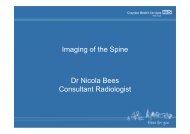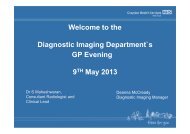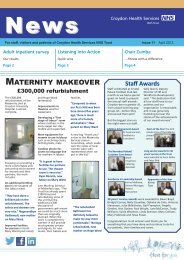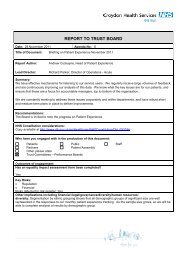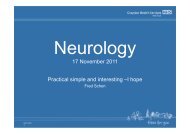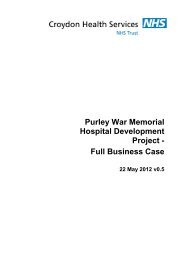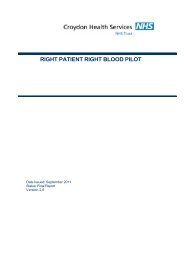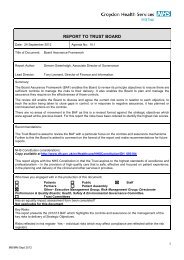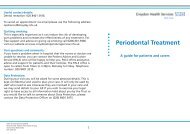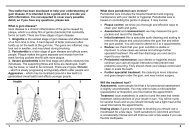Non-acute low back pain - Croydon Health Services NHS Trust
Non-acute low back pain - Croydon Health Services NHS Trust
Non-acute low back pain - Croydon Health Services NHS Trust
Create successful ePaper yourself
Turn your PDF publications into a flip-book with our unique Google optimized e-Paper software.
Exercises. They are designed to strengthen the <strong>back</strong> and stomach muscles<br />
as well as improve the flexibility of the <strong>back</strong>. A little <strong>pain</strong> is OK during these<br />
exercises. Stop or decrease exercises that cause <strong>pain</strong> or linger for more than<br />
30 minutes. Exercises should not increase any legs symptoms.<br />
Lower abdominal strengthening.<br />
Commonly called abdominal bracing, because<br />
they act like a “brace” or corset to keep the<br />
<strong>back</strong> stable.<br />
Place the fingers inside the bony points of the pelvis at the front. Gently ( 40% effort)<br />
draw in the <strong>low</strong>er stomach towards the spine without breathing in. You should feel the<br />
<strong>low</strong>er abdominals contracting under your fingers. Hold for 3 breaths. Repeat 10 times.<br />
Hamstring stretch.<br />
S<strong>low</strong>ly straighten one knee until a stretch is felt in the <strong>back</strong> of<br />
the thigh. Keep the <strong>low</strong>er <strong>back</strong> straight and do not lean<br />
<strong>back</strong>wards.<br />
Pelvic tilt. To stretch the <strong>low</strong>er <strong>back</strong> muscles. Try either position shown<br />
S<strong>low</strong>ly tighten the <strong>low</strong>er abdominal muscles and hol<strong>low</strong> the stomach to push the<br />
<strong>low</strong>er <strong>back</strong> into the bed. Start the movement by tilting the pelvis. Hold 10<br />
seconds. Repeat 5-10 times.<br />
Bridging.<br />
Hol<strong>low</strong> the stomach as above then gently<br />
squeeze the buttocks to tuck the pelvis<br />
under further and s<strong>low</strong>ly lift the pelvis just<br />
clear of the floor. Hold for 3 seconds.<br />
Repeat 5-10 times.<br />
Lower <strong>back</strong> mobilising.<br />
Roll your knees together from side to side.<br />
Repeat 5-10 times.<br />
<strong>Croydon</strong> <strong>Health</strong> <strong>Services</strong><br />
PHYSIOTHERAPY SERVICE 2011<br />
NON ACUTE LOW BACK PAIN<br />
<strong>Non</strong> <strong>acute</strong> <strong>low</strong> <strong>back</strong> <strong>pain</strong> is <strong>pain</strong> for more than six weeks.<br />
Most <strong>back</strong> <strong>pain</strong> is not caused by serious disease. It is called<br />
“mechanical”, that is something has gone wrong with the mechanical<br />
workings of the spine.<br />
ANATOMY<br />
The spine looks complicated,<br />
but in fact it consists of a series<br />
of bones called the vertebrae<br />
joined together by the discs.<br />
The disc’s purpose is to al<strong>low</strong> movement between the vertebrae.<br />
Injuries to the disc are fairly common. Strains caused by<br />
repetitive lifting, bending and twisting add up over the years.<br />
This may cause disruption and tears in the <strong>back</strong> of the disc, its<br />
weakest part.<br />
At the <strong>back</strong> of the spine are small joints called facet joints which<br />
control movement. As with all joints facet joints may suffer from<br />
“wear and tear”.<br />
Osteo-arthritis increases in frequency with age and in many<br />
cases fol<strong>low</strong>s misuse causing abnormal wear and tear to the<br />
discs and facet joints.<br />
Ligaments are fibrous tissue which join bones together, giving<br />
stability to the spine. Ligaments have a protective function to<br />
limit movement and if overstretched they become <strong>pain</strong>ful.<br />
The spine is completely surrounded by muscles. They have two<br />
purposes:
1. To keep your spine stable so that your arms and legs<br />
can move efficiently. The abdominal muscles are especially<br />
important for this.<br />
2. To move your spine. Back <strong>pain</strong> causes some muscles to<br />
weaken, especially the abdominal muscles. Other muscles<br />
can become overactive or go into spasm and tighten.<br />
ADVICE FOR NON ACUTE LOW BACK PAIN. Ways of<br />
maintaining or improving your spine.<br />
GENERAL FITNESS<br />
Keeping fit and active helps maintain strong <strong>back</strong> and stomach<br />
muscles which support the spine. Walking and swimming<br />
are excellent for the <strong>back</strong>. Swimming is helpful because<br />
it tones up the muscles without weight going through<br />
the joints. Breastroke can strain your <strong>back</strong> and neck, front<br />
crawl or <strong>back</strong>stroke may be better, but try and vary the<br />
strokes.<br />
Aim to exercise for 30 minutes 5 times per week.<br />
WATCH YOUR WEIGHT<br />
Being overweight for your height and sex can add extra<br />
stress to your spine.<br />
MAINTAIN GOOD POSTURE<br />
The way you sit, stand and work.<br />
There is a surprising amount of pressure through the spine<br />
when you sit. This is why sitting for long periods bothers<br />
most people with <strong>back</strong> <strong>pain</strong>. The pressure is reduced if the<br />
<strong>low</strong> <strong>back</strong> is supported.<br />
Standing still can be uncomfortable for people with <strong>back</strong><br />
problems. The longer you stand, the more the <strong>low</strong> <strong>back</strong><br />
tends to arch, causing <strong>back</strong>ache. Gently tightening your<br />
<strong>low</strong>er stomach muscles when standing will help.<br />
Vary your activity so that you aren’t in the same position for<br />
hours on end. For example take frequent short breaks from<br />
sitting.<br />
CONSIDER YOUR EVERYDAY ACTIVITIES<br />
Think of your <strong>back</strong> when shopping, gardening, cleaning, lifting<br />
and driving. Do not try to do everything at once—pace<br />
your activities.<br />
While shopping carry heavy goods in two bags, splitting the<br />
weight between each arm. Consider having your groceries delivered<br />
or take someone with you when you go shopping. Get<br />
someone else to push the trolley.<br />
Housework can put a great strain on <strong>back</strong>s. Learn to take frequent<br />
breaks between chores. Spread a task out through the<br />
week rather than attempting to complete it in one go. e.g. the<br />
vacuuming or ironing. Never struggle on until the <strong>pain</strong> forces<br />
you to stop.<br />
In the garden try some gentle stretching before you start.<br />
Choose lightweight long handled tools. Switch tasks about so<br />
that you only do a little of each at a time. Plant from kneeling<br />
using knee pads or a kneeler.<br />
While driving try and maintain correct sitting posture. Power<br />
steering puts less strain on the <strong>back</strong> and neck. Adjust the seat<br />
so you can comfortably reach the pedals and steering wheel.<br />
On long journeys, stop every hour and walk around for a few<br />
minutes.<br />
Become more aware of how you lift, learn the correct principles.<br />
Bend your knees not your <strong>back</strong>. Do not lift anything that<br />
is too heavy.<br />
When all your chores are complete, the worst thing you can do<br />
is slump in an armchair. Give your spine a rest during the day<br />
by lying on your <strong>back</strong>. Choose a comfortable position. Try<br />
lying on your <strong>back</strong> with a pil<strong>low</strong> under the knees or <strong>low</strong>er<br />
<strong>back</strong>.




